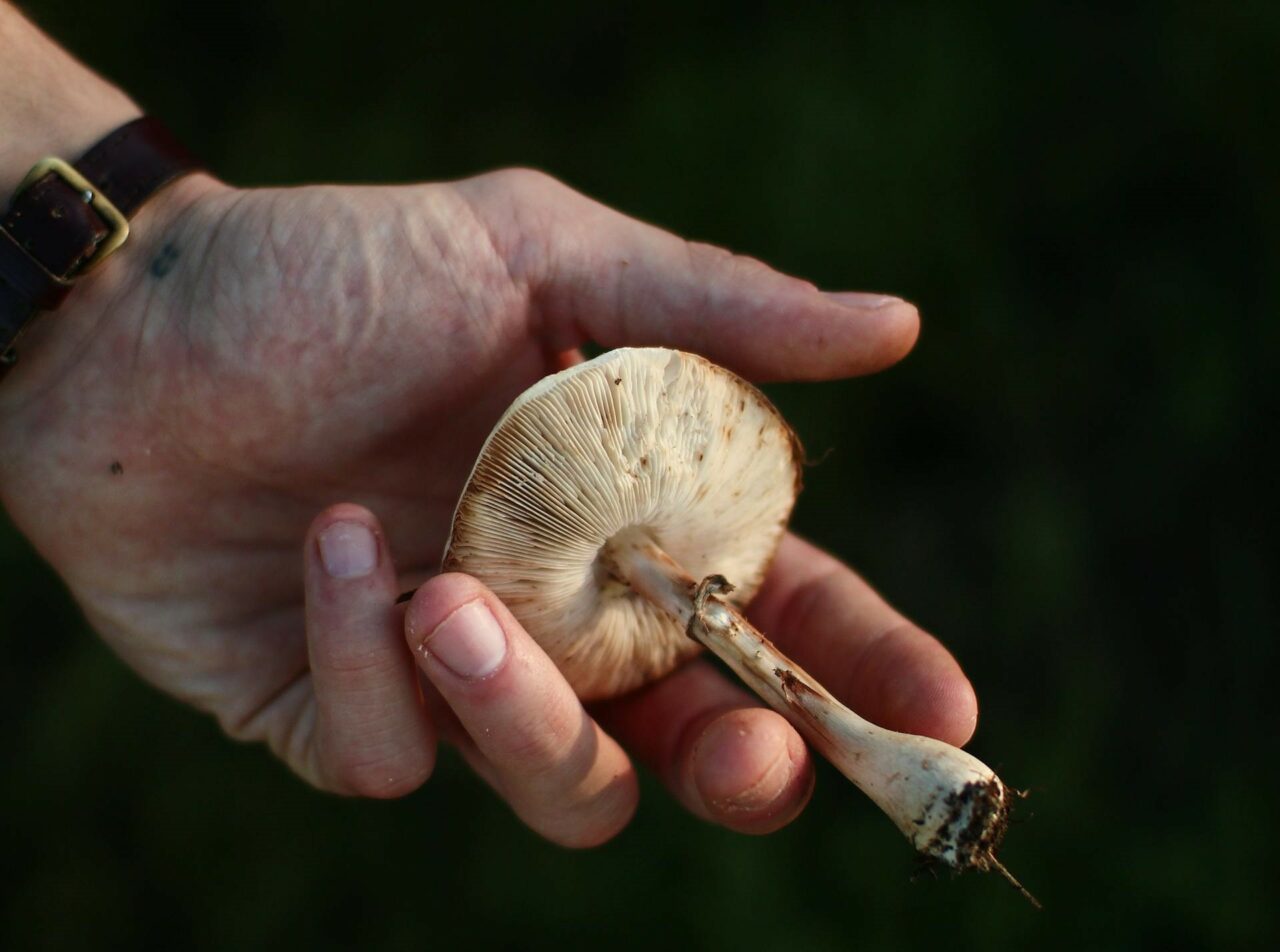Traditional psychedelics like Psilocybin mushrooms, similar to LSD in their function as a serotonin 5-HT2A receptor agonist, are currently under research for the potential role in psilocybin-assisted therapy. This therapy aims to address mental health disorders such as emotional turmoil linked with major depression, anxiety, cluster headaches, and migraines.
Understanding the metabolism of shrooms in our body is pivotal to comprehend how they can assist with these conditions. This knowledge empowers researchers and users to discern how the active compound brings about its psychological and therapeutic impacts. This write-up offers an essential overview of psilocybin’s pharmacology and pharmacokinetics.
[toc]
Key Points:
- Upon oral consumption, half of the psychedelic fungi is absorbed and disseminated throughout the body.
- The compound in the fungi undergoes dephosphorylation through the enzyme alkaline phosphatase, primarily within the liver.
- Within 24 hours, about 3.4% of the compound is expelled in its original form, while the bulk is eliminated as a stable metabolite.
What does Pharmacokinetics Mean?
Pharmacokinetics (PK) is a field of study that examines how substances like drugs are processed by the body once they get into the system. It’s closely related, but different from pharmacodynamics, which studies how a compound interacts with the body. PK mainly focuses on four aspects: absorption, distribution, metabolism, and excretion (ADME).
Knowledge of these processes enables healthcare professionals to prescribe the most suitable drugs with the least risk. It also allows them to customize treatments to each patient’s particular physiology and lifestyle.
How does Pharmacokinetics relate to Psilocybin?
Psilocybin and psilocin, the primary active compounds in certain magic mushroom species, have piqued substantial interest among researchers and users. Pharmacokinetics studies how the body processes mushrooms containing psilocybin, aiding in understanding their potential effects, whether for medicinal or recreational use.
The compounds are recognized by various names, including “magic,” “psychedelic,” “medicinal,” or “sacred.” The consumption of fungi containing these compounds is prevalent, with The varieties of mushrooms, their place of origination, size, the circumstances under which they grow and are dried, and their age can all contribute to significant variations in their concentrations.
Although these mushrooms naturally occur in the wild, scientists have devised ways to artificially produce them in the lab. Both the natural and synthetic versions exhibit minimal toxicity, but minor side effects such as nausea or vomiting may be experienced.
Despite these physical impacts, the compounds in the mushrooms have demonstrated potential therapeutic advantages due to their safety profile and non-addictive nature. These benefits have prompted researchers to explore their application in psychotherapy, specifically as a remedy for anxiety and depression.
The 4 Phases of Pharmacokinetics
Psilocybin, the compound found in these mushrooms, is inactive in its unprocessed form and functions as a prodrug, converting into its active form, psilocin. Enzymes like alkaline phosphatase facilitate this transformation, enabling psilocin to be absorbed and distributed throughout the body, reaching various tissues. However, after oral administration, psilocybin is not detectable in the circulatory system, feces, or urine.
Absorption
Absorption refers to the process by which the compound enters the bloodstream from its point of administration. It affects the speed and efficiency with which the compound reaches its target, such as the plasma. The most commonly used method of administration is oral. Inhalation has been tried, but it is not as effective as oral ingestion.
The absorption process also involves the release of the compound from the dosage form during oral ingestion. Factors such as a delay in the throat or esophagus can affect this, potentially slowing down the effects or causing irritation. Once the compound reaches the stomach, the acidic environment may start to break it down before it enters the bloodstream.
Studies conducted on animals suggest that only about 50% of orally administered psychedelics are absorbed and distributed throughout the body.
Factors Affecting the Absorption Process
Several factors can influence the absorption process, leading to variations in the onset, intensity, and duration:
- Stomach Contents: Having a full stomach can delay the process as it slows down the onset of effects. An empty stomach facilitates quicker absorption.
- Body Fat: Substances can be stored in fatty tissues, potentially prolonging their effects.
- Age: As individuals age, metabolic rates and body composition often change.
- Zero-Order Kinetics: The substance is expelled at a constant rate, regardless of its concentration.
- First-Order Kinetics: The elimination rate is related to the drug’s concentration.
Distribution references the dispersion of psilocin in the body after it has been introduced into the bloodstream. Given its lipophilic nature, psilocin can traverse the blood-brain barrier and access the central nervous system.
This process is influenced by a variety of factors, including the product’s size, polarity, and protein-binding capacity, as well as individual physiological factors, such as hydration status and body composition.
The aim is to achieve an effective concentration at the target location. For the product to work, it must reach the target area, as established by the volume of distribution, while remaining unbound to proteins, which allows for active interaction with its receptor.
Which Factors Impact the Distribution Process?
Several factors can alter the distribution process:
Typically, effects begin to manifest within 20-40 minutes post-consumption, reaching a peak around 80-100 minutes. The effects of magic mushrooms generally persist for a period of 4-6 hours.
How is Distribution to the Brain Achieved?
An initial experimental investigation using two species demonstrated that its binding affinity order is 5HT2A > 5HT1A > 5HT2B [23]. It also has an affinity for dopamine D1, 5HT1E, 5HT5A, 5HT7, 5HT6, D3, 5HT2C, and 5HT1B receptors.
It acts as a partial agonist at the 5HT2A receptor, with an effectiveness of around 40%. The psychedelic effects are attributed to its partial agonist activity at 5HT1A autoreceptors.
The mood-enhancing and psychotomimetic experiences might be linked to the noted correlation between higher dopamine levels and feelings of depersonalization and euphoria. Hallucinogens operate by modifying neurochemistry and receptor activity. They enhance 5HT2A agonist activity by promoting BDNF synthesis in the hippocampus, which encourages neurogenesis and reduces fear-related behaviors.
The Process of Excretion
Excretion involves the process in which the The human body expels a substance mainly through the kidneys, but also through the lungs, skin, and gastrointestinal tract. When it comes to kidneys, a naturally occurring psychedelic substance gets filtered in the glomerulus or secreted in the tubules, making the reabsorption process more complex.
The primary substance has a half-life of roughly 160 minutes, while psilocin’s half-life is approximately 50 minutes. Research on animals indicates that it is mainly excreted through urine, making up around 65% within 8 hours. Traces of the substance can still be detected in smaller amounts in bile and feces after consumption.
In humans, around 3.4% of the substance is eliminated in its original form in a day, while the larger proportion is expelled as psilocin-O-glucuronide, a more stable metabolite. This stability allows the substance to be identified in urine samples for a longer period.
There are two primary ways of substance elimination:
Most hallucinogenic substances follow the first-order kinetics method, achieving steady-state concentrations after four to five half-lives. Complete removal also occurs after four to five half-lives.
Discover Our Variety of Psychedelic Mushrooms
The metabolic process differs among various types of fungi. To avoid the accidental ingestion of poisonous mushrooms, purchase from reliable online vendors like Shroom Delivery Toronto Canada. Some species, such as Agaric mushrooms, can produce strong and unpleasant effects. Therefore, it’s essential to obtain magic mushrooms from credible sources rather than from potentially risky street sellers or wild foraging.
| Feature | Enigma | Full Moon Party | Gold Member | |
| Strain Type | Psilocybe Cubensis OMNI | Psilocybe cubensis (Thai Koh Samui) | Psilocybe cubensis | |
| Potency | Exceptionally high; 3.8% tryptamine content | Moderate to high potency | High potency | |
| Visual Characteristics | Resembles a blob or | Resembling a cauliflower or brain | Exhibits the typical cubensis characteristics; of moderate size | Thick, white stems; caps in a golden caramel colour; evident blue bruising |
| Effects | Considered the most potent; triggers intense effects | Provokes a strong mental high; onset is delayed but includes pronounced visuals | Produces strong visuals and euphoria |
Explore Psilocybin Mushroom Use Online
It’s crucial for medical experts, researchers, and users to understand the pharmacokinetics of shrooms. This knowledge empowers you to make educated decisions about dosage and timing, hence reducing potential risks.
Discover your perfect psychedelic experience at Shroom Delivery Toronto Canada. Whether you desire a relaxing trip or a deeper exploration, our extensive selection is tailored to meet your particular needs. Enjoy top-tier, safe, and quality-checked shrooms, eliminating worries about unreliable sources or poisonous mushrooms.
Sample the best magic mushrooms Canada has to offer and raise your psychedelic journey to unparalleled heights.
Frequently Asked Questions
Do shrooms interact with any medications?
Our products may interact with certain medicines, particularly those that affect serotonin levels, such as SSRIs (Selective Serotonin Reuptake Inhibitors). SSRIs and SNRIs (Serotonin and Norepinephrine Reuptake Inhibitors) can reduce the effects, unlike non-serotonergic antidepressants. This reduced effect can last up to three months after discontinuing the antidepressant.
Do all psychedelics function like psilocybin?
No, each psychedelic substance has a unique structure that requires different metabolic processes to activate, and they attach to various receptors in the body. The way of administration also affects each psychedelic’s absorption. While the basic principles of absorption, metabolism, and distribution stay the same, the specific pathways and effects vary for each substance.
Does the form of the shroom affect pharmacokinetics?
Yes, the form (whether fresh, powdered, or dried mushrooms) can influence the absorption rate. For example, powdered forms might be absorbed quicker than whole dried ones due to faster dissolution.
Related Reads:





